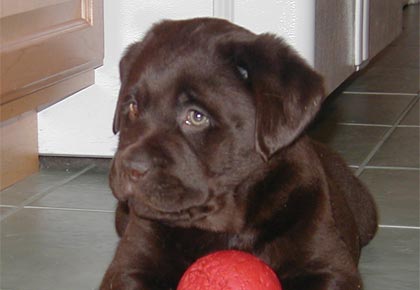When should I spay-neuter my puppy?
Spay or Neutering your puppy – When Should You do it?
Most people hear that you should spay or neuter your puppy as soon as possible (as young as 6 months old), so as to diminish the unwanted puppy population. While we agree that there is unfortunately a growing population of unplanned puppies, there are also valid arguments for waiting to spay or neuter a dog, that affect its lifetime health. The article below covers the scientific evidence behind those arguments.
-Endless Mt. Labradors
A great video to watch on this subject!
[youtube]https://www.youtube.com/watch?v=enPCZA1WFKY[/youtube]
Early Spay-Neuter Considerations for the Canine Athlete
One Veterinarian’s Opinion
© 2005 Chris Zink DVM, PhD, DACVP
www.caninesports.com
Those of us with responsibility for the health of canine athletes need to continually read and evaluate new scientific studies to ensure that we are taking the most appropriate care of our performance dogs.

This article provides evidence through a number of recent studies to suggest that veterinarians and owners working with canine athletes should revisit the standard protocol in which all dogs that are not intended for breeding are spayed and neutered at or before 6 months of age.
Orthopedic Considerations
A study by Salmeri et al in 1991 found that bitches spayed at 7 weeks grew significantly taller than those spayed at 7 months, who were taller than those not spayed (or presumably spayed after the growth plates had closed).(1)A study of 1444 Golden Retrievers performed in 1998 and 1999 also found bitches and dogs spayed and neutered at less than a year of age were significantly taller than those spayed or neutered at more than a year of age.(2) The sex hormones, by communicating with a number of other growth-related hormones, promote the closure of the growth plates at puberty (3), so the bones of dogs or bitches neutered or spayed before puberty continue to grow. Dogs that have been spayed or neutered well before puberty can frequently be identified by their longer limbs, lighter bone structure, narrow chests and narrow skulls. This abnormal growth frequently results in significant alterations in body proportions and particularly the lengths (and therefore weights) of certain bones relative to others. For example, if the femur has achieved its genetically determined normal length at 8 months when a dog gets spayed or neutered, but the tibia, which normally stops growing at 12 to 14 months of age continues to grow, then an abnormal angle may develop at the stifle. In addition, with the extra growth, the lower leg below the stifle likely becomes heavier (because it is longer), and may cause increased stresses on the cranial cruciate ligament. In addition, sex hormones are critical for achieving peak bone density.(4) These structural and physiological alterations may be the reason why at least one recent study showed that spayed and neutered dogs had a higher incidence of CCL rupture.(5 Another recent study showed that dogs spayed or neutered before 5 1/2 months had a significantly higher incidence of hip dysplasia than those spayed or neutered after 5 1/2 months of age, although it should be noted that in this study there were no standard criteria for the diagnosis of hip dysplasia.(6) Nonetheless, breeders of purebred dogs should be cognizant of these studies and should consider whether or not pups they bred were spayed or neutered when considering breeding decisions.
Cancer Considerations
A retrospective study of cardiac tumors in dogs showed that there was a 5 times greater risk of hemangiosarcoma, one of the three most common cancers in dogs, in spayed bitches than intact bitches and 2.4 times greater risk of hemangiosarcoma in neutered dogs as compared to intact males.(7) A study of 3218 dogs demonstrated that dogs that were neutered before a year of age had a significantly increased chance of -developing bone cancer.(8) A separate study showed that neutered dogs had a two-fold higher risk of developing bone cancer.(9) Despite the common belief that neutering dogs helps prevent prostate cancer, at least one study suggests that neutering provides no benefit.(10) There certainly is evidence of a slightly increased risk of mammary cancer in female dogs after one heat cycle, and for increased risk with each subsequent heat. While about 30 % of mammary cancers are malignant, as in humans, when caught and surgically removed early the prognosis is very good.(12) Luckily, canine athletes are handled frequently and generally receive prompt veterinary care.
Behavioral Considerations
The study that identified a higher incidence of cranial cruciate ligament rupture in spayed or neutered dogs also identified an increased incidence of sexual behaviors in males and females that were neutered early.(5) Further, the study that identified a higher incidence of hip dysplasia in dogs neutered or spayed before 5 1/2 months also showed that early age gonadectomy was associated with an increased incidence of noise phobias and undesirable sexual behaviors.(6) A recent report of the American Kennel Club Canine Health Foundation reported significantly more behavioral problems in spayed and neutered bitches and dogs. The most commonly observed behavioral problem in spayed females was fearful behavior and the most common problem in males was aggression.(12)
Other Health Considerations
A number of studies have shown that there is an increase in the incidence of female urinary incontinence in dogs spayed early (13), although this finding has not been universal. Certainly there is evidence that ovarian hormones are critical for maintenance of genital tissue structure and contractility.(14, 15) Neutering also has been associated with an increased likelihood of urethral sphincter incontinence in males.(16) This problem is an inconvenience, and not usually life-threatening, but nonetheless one that requires the dog to be medicated for life. A health survey of several thousand Golden Retrievers showed that spayed or neutered dogs were more likely to develop hypothyroidism.(2) This study is consistent with the results of another study in which neutering and spaying was determined to be the most significant gender-associated risk factor for development of hypothyroidism.(17) Infectious diseases were more common in dogs that were spayed or neutered at 24 weeks or less as opposed to those undergoing gonadectomy at more than 24 weeks.(18) Finally, the AKC-CHF report demonstrated a higher incidence of adverse reactions to vaccines in neutered dogs as compared to intact.(12) I have gathered these studies to show that our practice of routinely spaying or neutering every dog at or before the age of 6 months is not a black-and-white issue. Clearly more studies need to be done to evaluate the effects of prepubertal spaying and neutering, particularly in canine athletes. Currently, I have significant concerns with spaying or neutering canine athletes before puberty. But of course, there is the pet overpopulation problem. How can we prevent the production of unwanted dogs while still leaving the gonads to produce the hormones that are so important to canine growth and development? One answer would be to perform vasectomies in males and tubal ligation in females, to be followed after maturity by ovariohysterectomy in females to prevent mammary cancer and pyometra. One possible disadvantage is that vasectomy does not prevent some unwanted behaviors associated with males such as marking and humping. On the other hand, females and neutered males frequently participate in these behaviors too. Really, training is the best solution for these issues. Another possible disadvantage is finding a veterinarian who is experienced in performing these procedures. Nonetheless, some do, and if the procedures were in greater demand, more veterinarians would learn them.
I believe it is important that we assess each situation individually. For canine athletes, I currently recommend that dogs and bitches be spayed or neutered after 14 months of age.
And, cosmetically, if you want your dog to look like the beautiful parents of your pup. Here’s an example of two littermates, one spayed between 6-12 mos, the other never spayed (went into a breeding program) Note the incredible development stagnation of the one spayed early:
(End of article)
***We recommend not spaying or neutering before 18-24 mos since the growth plates are not growing until that time. If you do, you will have unstable joints and be more susceptible to cruciate ligament tears, ACL issues, hyperextension, hip dysplasia and elbow dysplasia. Also, don’t forget, hormones also contribute to how your dog LOOKS. (Imagine cutting off an 11-year-old boy’s hormones…where would that 25 year old be???) Structural growth is done by 24 mos. of age in canines…and the third year they really muscle out, chest drops, head comes in. If you neuter/spay early, your dog will be dwarfed, and will NOT look like its parents. Do not fall for the false “he’ll get testicular cancer” or “she’ll get breast cancer”… as you can see from the research above, it is just the opposite!!*** (Vets have been giving the HSUS and PETA ‘spay/neuter early’ line for years, only caring about ‘unwanted puppies and kittens” with no consideration for the long-term health of your canine family member. If your vet wants to neuter/spay early, you may want to search out a younger vet, or one familiar with the latest research. Holistic vets are the BEST choice!) We know you all want your dogs to live long, pain-free lives, and to look like the beautiful English labs you know us for!
And remember…altering hormones causes shedding (ask any woman that has had a hysterectomy…hair loss is a side effect)
LEARN MORE IN OUR YOUTUBE VIDEO “WHEN SHOULD I SPAY/NEUTER MY DOG HERE: https://www.youtube.com/watch?v=GJOz0eNCtUo
References:
1. Salmeri KR, Bloomberg MS, Scruggs SL, Shille V.. Gonadectomy in immature dogs: effects on skeletal, physical, and behavioral development. JAVMA 1991;198:1193-1203
2. http://www.grca.org/healthsurvey.pdf
3. Grumbach MM. Estrogen, bone, growth and sex: a sea change in conventional wisdom. J Pediatr Endocrinol Metab. 2000;13 Suppl 6:1439-55.
4. Gilsanz V, Roe TF, Gibbens DT, Schulz EE, Carlson ME, Gonzalez O, Boechat MI. Effect of sex steroids on peak bone density of growing rabbits. Am J Physiol. 1988 Oct;255(4 Pt 1):E416-21.
5. Slauterbeck JR, Pankratz K, Xu KT, Bozeman SC, Hardy DM. Canine ovariohysterectomy and orchiectomy increases the prevalence of ACL injury. Clin Orthop Relat Res. 2004 Dec;(429):301-5.
6. Spain CV, Scarlett JM, Houpt KA. Long-term risks and benefits of early-age gonadectomy in dogs. JAVMA 2004;224:380-387.
7. Ware WA, Hopper DL. Cardiac tumors in dogs: 1982-1995. J Vet Intern Med 1999 Mar-Apr;13(2):95-103
8. Cooley DM, Beranek BC, Schlittler DL, Glickman NW, Glickman LT, Waters D, Cancer Epidemiol Biomarkers Prev. 2002 Nov;11(11):1434-40
9. Ru G, Terracini B, Glickman LT. Host related risk factors for canine osteosarcoma. Vet J. 1998 Jul;156(1):31-
10. Obradovich J, Walshaw R, Goullaud E. The influence of castration on the development of prostatic carcinoma in the dog. 43 cases (1978-1985). J Vet Intern Med 1987 Oct-Dec;1(4):183-7
11. http://www.akcchf.org/pdfs/whitepapers/Biennial_National_Parent_Club_Canine_Health_Conference.pdf
12. Meuten DJ. Tumors in Domestic Animals. 4th Edn. Iowa State Press, Blackwell Publishing Company, Ames, Iowa, p. 575
13. Stocklin-Gautschi NM, Hassig M, Reichler IM, Hubler M, Arnold S. The relationship of urinary incontinence to early spaying in bitches. J. Reprod. Fertil. Suppl. 57:233-6, 2001
14. Pessina MA, Hoyt RF Jr, Goldstein I, Traish AM. Differential effects of estradiol, progesterone, and testosterone on vaginal structural integrity. Endocrinology. 2006 Jan;147(1):61-9.
15. Kim NN, Min K, Pessina MA, Munarriz R, Goldstein I, Traish AM. Effects of ovariectomy and steroid hormones on vaginal smooth muscle contractility. Int J Impot Res. 2004 Feb;16(1):43-50.
16. Aaron A, Eggleton K, Power C, Holt PE. Urethral sphincter mechanism incompetence in male dogs: a retrospective analysis of 54 cases. Vet Rec. 139:542-6, 1996
17. Panciera DL. Hypothyroidism in dogs: 66 cases (1987-1992). J. Am. Vet. Med. Assoc., 204:761-7 1994
18. Howe LM, Slater MR, Boothe HW, Hobson HP, Holcom JL, Spann AC. Long-term outcome of gonadectomy performed at an early age or traditional age in dogs. J Am Vet Med Assoc. 2001 Jan 15;218(2):217-21.
Other articles:
http://www2.dcn.org/orgs/ddtc/sfiles/LongTermHealthEffectsOfSpayNeuterInDogs.pdf
http://www.therio.org/displaycommon.cfm?an=1&subarticlenbr=191
Related Articles
DO NOT BUY A PUPPY OR DOG UNTIL YOU READ THIS!!! (Donna\’s full-length memoir/Labrador History)
Why your Lab should stop biting and jumping on–GET THIS!!–DAY #1!!!
Purebred Thefts on the Rise! (and in the news)
Does your Pet Shampoo contain these harmful chemicals?
Buyer Beware
Am I crazy to want two puppies??










105 Comments